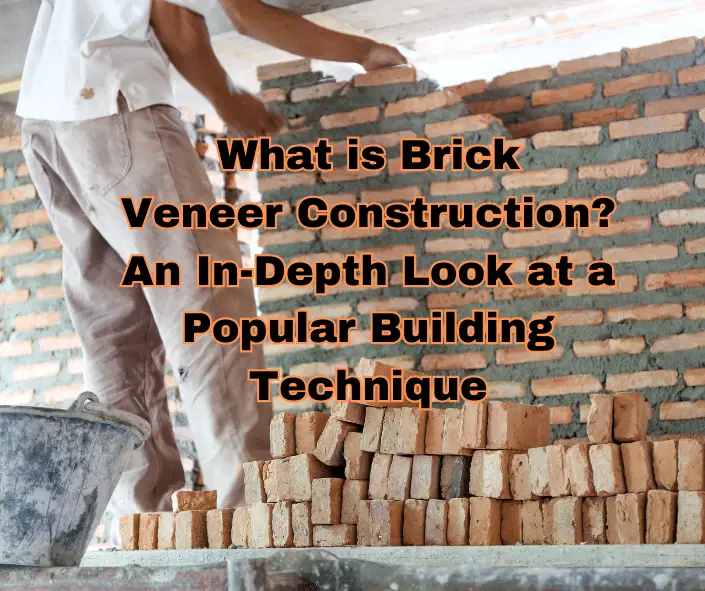Brick veneer construction has become increasingly popular in the world of residential and commercial building, offering the classic appearance of solid brick walls while taking advantage of modern construction techniques. In this article, we will delve into the details of brick veneer construction, its advantages and disadvantages, and answer some popular questions related to this construction method.
What is Brick Veneer Construction?
Brick veneer construction is a building method that employs a single layer of bricks as a non-structural, decorative facade over another type of structural wall, typically made of wood or steel framing, concrete, or masonry block. This single layer of bricks, called the veneer, is attached to the structural wall using ties or metal fasteners. The primary purpose of brick veneer is to provide the appearance of a traditional solid brick wall while benefiting from the advantages of the underlying structural wall system.
Advantages of Brick Veneer Construction
- Aesthetics: Brick veneer offers the classic, timeless appearance of a solid brick wall, enhancing curb appeal and blending well with various architectural styles.
- Cost-effective: Brick veneer construction is generally less expensive than solid brick walls, as it requires fewer bricks and less labor to install.
- Insulation: The air gap between the brick veneer and the structural wall serves as a thermal break, improving energy efficiency and insulation performance.
- Maintenance: Brick veneer is durable and requires minimal maintenance, as it doesn’t rot or warp like wood siding.
- Moisture management: The cavity between the veneer and the structural wall helps manage moisture, allowing it to evaporate or drain away, reducing the likelihood of mold and water damage.
Disadvantages of Brick Veneer Construction
- Susceptibility to water penetration: If not properly installed, brick veneer can be vulnerable to water infiltration, which may lead to structural damage.
- Regular inspection and maintenance: Brick ties and weep holes must be regularly inspected and maintained to prevent moisture buildup and ensure the long-term performance of the brick veneer.
Brick Mortar Calculator
Are you embarking on a bricklaying project and need an accurate estimate of the number of bricks required? Look no further! Our Brick Mortar Calculator is here to simplify the process and provide you with precise calculations
How is brick veneer installed?
The installation process involves laying a single layer of bricks over a structural wall using brick ties or metal fasteners. A cavity, typically between 1-2 inches wide, is left between the veneer and the structural wall to allow for drainage and ventilation. Weep holes are also installed at the bottom of the veneer to facilitate moisture drainage.
Is brick veneer a good insulator?
While brick veneer itself isn’t an effective insulator, the air gap between the veneer and the structural wall can improve the overall insulation performance of the wall system. The cavity acts as a thermal break, reducing heat transfer between the exterior and interior environments.
Can brick veneer be retrofitted to an existing building?
Yes, brick veneer can be added to an existing building to improve its aesthetics and potentially enhance its energy efficiency. However, the retrofit process can be more complex and costly than installing brick veneer during initial construction.
Is brick veneer waterproof?
Brick veneer is not inherently waterproof, and water can penetrate the porous surface of bricks. Proper installation techniques, such as the inclusion of a water-resistant barrier and flashing, are necessary to minimize the risk of water infiltration.
Brick Veneer is Sometimes Referred to by Other Names, Including:
- Brick facing: This term is often used interchangeably with brick veneer to describe the single layer of bricks applied as a decorative facade over a structural wall.
- Brick cladding: Cladding is a general term used to describe any material applied to the exterior of a building for aesthetic or functional purposes. In the case of brick veneer, the term “brick cladding” highlights the fact that it’s a non-structural, decorative layer.
Despite the different names, these terms all refer to the same concept: a single layer of bricks used as a non-structural, decorative facade over another type of structural wall.
Are Brick Slips The Same as Brick Veneer
Brick slips, also known as brick tiles or brick veneer tiles, are similar to brick veneer in that they are used as a non-structural, decorative facade over another type of structural wall. However, there is a key difference between the two: while brick veneer involves a single layer of full-sized bricks, brick slips are thin, lightweight slices of brick, typically around 15-25 mm (0.6-1 inch) thick.
Brick Slips | Should You Use Them
Brick slips are manufactured by either cutting the face off full-sized bricks or by extrusion and kiln-firing processes similar to those used for regular bricks. They can be applied to a variety of surfaces, such as concrete, masonry, or even drywall, using adhesives or mortar. Once installed, they give the appearance of a traditional brick wall, but with a reduced weight and thickness compared to brick veneer.
Some advantages of brick slips over brick veneer include:
- Weight: Brick slips are lighter than full-sized bricks, making them suitable for applications where weight is a concern, such as interior walls, facades of lightweight construction, or retrofitting on existing structures.
- Versatility: Due to their thin profile, brick slips can be used in a wider range of situations, including interior design projects, feature walls, or curved surfaces.
- Ease of installation: Brick slips can be easier to install than full-sized bricks, as they can be adhered using adhesives or thin-set mortar and don’t require brick ties or metal fasteners.
Despite these advantages, brick slips may not be as durable as brick veneer, and they may not provide the same level of insulation or moisture management as a full-sized brick veneer with a cavity. It’s essential to consider the specific needs and goals of a project when deciding between brick slips and brick veneer.
Conclusion
Brick veneer construction is a versatile and popular building technique that combines the classic aesthetics of solid brick walls with the benefits of modern structural systems. By understanding the advantages, disadvantages, and common questions surrounding brick veneer, homeowners and builders can make informed decisions about whether this construction method is suitable for their projects.
Author Profile

- I have many qualifications and certificates in construction, such as City & Guilds, CPCS and CITB. These are the highest standards of training and competence in the industry. Whether you need help with plumbing, carpentry, bricklaying or any other trade, I’m here to help you succeed.
Latest entries
- March 6, 2024CalculatorsWall Tile Calculator: How Many Wall Tiles Do You Need
- February 29, 2024Roof Truss Cost Calculator
- December 31, 2023Wage Take Home Calculator
- December 30, 2023Day Rate Calculator

